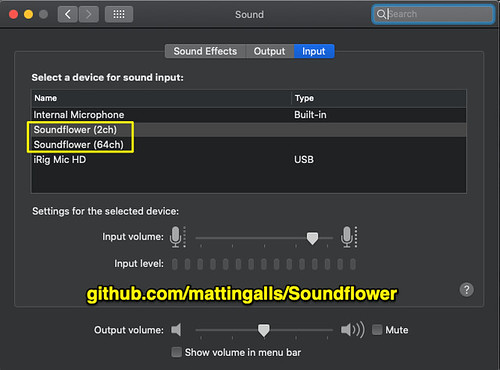
plist files, and its fellow travelers still reside on my hard drive.
#GITHUB SOUNDFLOWER PRO#
I have had SnapZ Pro installed on my systems for years without problems, but I believe that the version 1.6.6 beta version of SoundFlower, which I recently downloaded and installed as an "upgrade" caused havoc in my Mac Pro due to its inability to play nice in Mavericks.Ī separate File Buddy search for "SoundFlower" reveals that the application, its receipt files, its. Sudo rm -r /System/Library/Extensions/Soundflower.kext Sudo kextunload /System/Library/Extensions/Soundflower.kext To eliminate SoundFlower, or as she put, "nuke it from orbit," use these commands in Terminal, one after the other, then Restart your Mac: I did not read them, but I take her word for it. She said that there are several Apple discussions identifying SoundFlower as the culprit for crashes in Mavericks. It is an extension (kext) that gets loaded into your System's Library folder.Įvery Panic Report that I sent to Apple pointed out that SunFlower's extension was the cause, but it took a long phone call with a smart Senior Level tech support at Apple to read the Panic Reports I sent her and interpret what they meant. I just went through three (3) days of my MacPro suddenly crashing and automatically restarting more than a dozen time due to this culprit. SoundFlower version 1.6.6 beta is not compatible with Mavericks. Hearing the audio and can Shazam tracks at the same time.Avoid installing SoundFlower if you are using Mavericks. Set input and output to Loopback Audio (in System Preferences/Audio) and then as in the picture in loopback itself. I might've found an easier way to set it up with loopback. I don't know why this sometimes happens, because when I use some other Multi-Output Devices I have created that also includes my other computer connected via Thunderbolt in Target Display Mode, I can magically use the volume media keys as normal. But sometimes, the volume icon in the menu bar is grayed out and the volume can only be manipulated in Audio Midi Setup. Volume resetting to zero wouldn't have to be a big problem, if the normal volume controls (media keys and menu bar volume icon) worked as usual.There's quite a few tabs here, and the volume sliders on one of them may have been reset to zero. Be sure to check all tabs (Input/Output) on both the aggregated Output device and and its aggregated sub-devices. Check if the volume has been reset for the Multi-Output Device or any of it's sub-devices in Audio Midi Setup.
#GITHUB SOUNDFLOWER HOW TO#
It has stopped working a few times before, and while I haven't exactly identified how to mitigate the issue, I have noticed that something of the following may have helped to get it working again:

When originally composing this answer, I couldn't get it to work even though I hadn't modified the setup that was working the day before. HOWEVER, while the above will work at times, I have noticed that the behaviour of Soundflower can be erratic from time to time. Tip: You can also change the Input/Output settings by holding ⌥ ( alt/opt) and left-clicking the Volume icon in the OS X menu bar.

Now that you have created a Multi-Output Device, go back to System Preferences > Sound and select it on the Output tab as in Step 2. Now you can hear audio as usual while routing the Output into your Input via Soundflower. Mark to use both your Built-in Output and Soundflower (2ch). Press the + button in the bottom left corner, and press Create Multi-Output Device. It's located in your Applications folder under /Applications/Utilities. your Built-in speakers or attached headphones), you need to open the native OS X application Audio Midi Setup. If you want to hear the audio while it's playing on your normal Output device (e.g. You are now routing your Output to Input, and will be able to record the audio playing to an application like QuickTime, Evernote or Just Play Record. If you're okay with not having to hear the output yourself, you can now go to the Output tab and select Soundflower (2ch). If you want to route the audio and hear it yourself at the same time, skip to Step 3. Go to the Input tab and select Soundflower (2ch) as the input device. Step 1Īfter installation, a new device will be available in System Preferences > Sound.

It does this by routing your audio output as an audio input to the system. Soundflower is a virtual audio device for OS X that can pass audio from applications to other applications.

#GITHUB SOUNDFLOWER TRIAL#
Again, it is a paid product with a trial mode. It solves some issues with Soundflower, like reenabling volume up/down via the Mac media keys. Rogue Amoeba, the previous maintainers of the open source Soundflower project, has a new (paid) application called Loopback which seems to be easier and more dependable to work with than Soundflower.


 0 kommentar(er)
0 kommentar(er)
